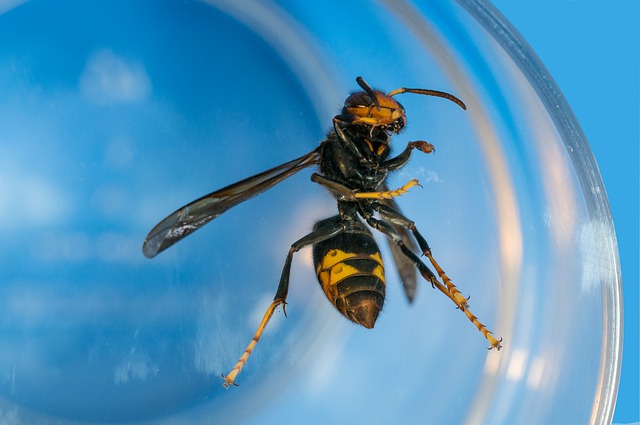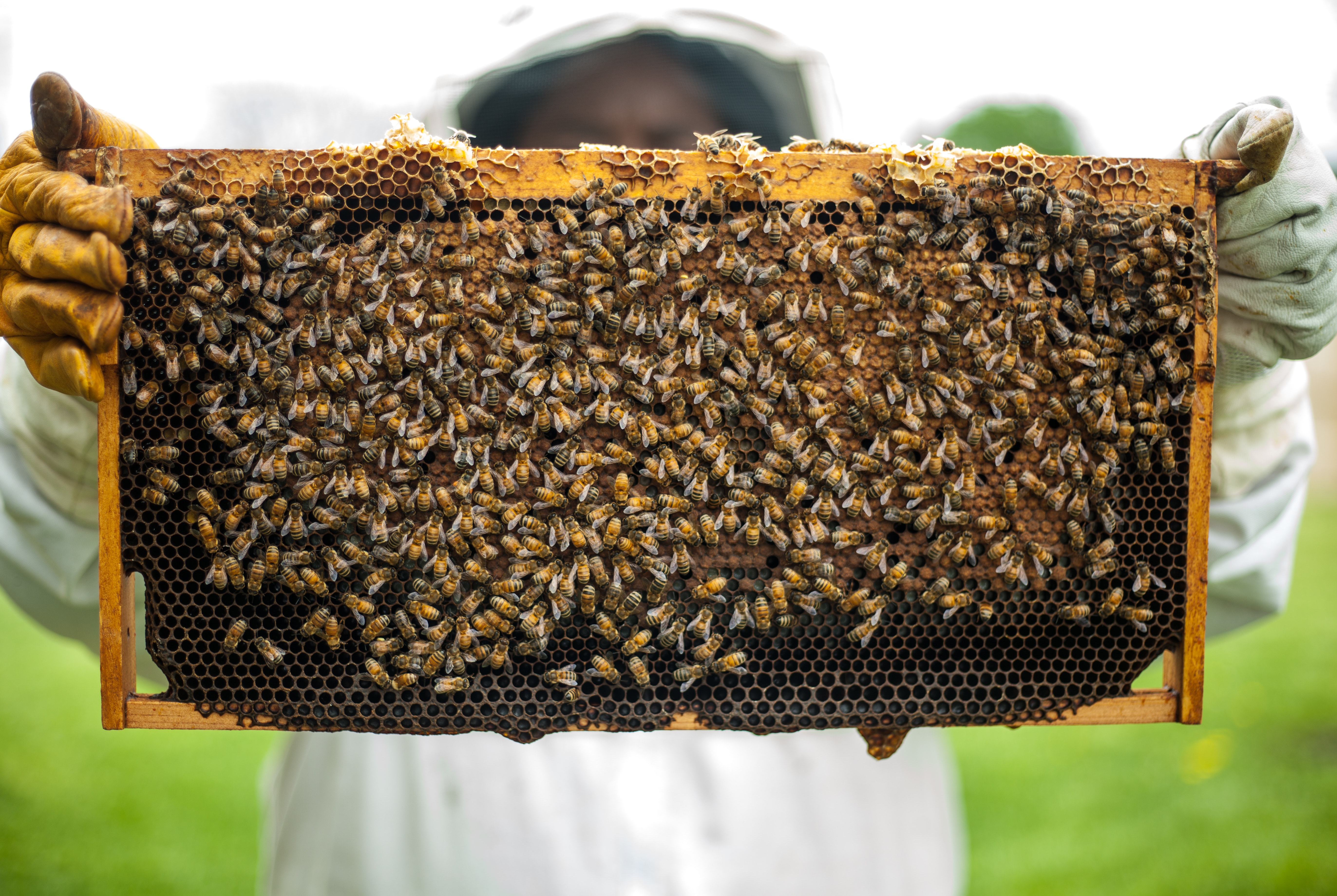by Elizabeth Ahearn, Atlantic Chapter Conservation Staff
Hornet Hype
In the midst of a news cycle overwhelmingly dominated by pandemic coverage, few other stories have gained high-profile attention — until the arrival of the murder hornet. The frenzy seemingly corresponded with a story released on May 2 by The New York Times. Within twenty-four hours, the hashtag #murderhornets was trending on Twitter, and widespread media hype generated a narrative of a terrifying, five-centimeter-long hornet invading the United States. Photos and videos showing the species savagely attacking honeybee hives and decapitating bees quickly went viral, further contributing to the insect’s growing vicious reputation. Two dead “murder hornets,” more officially known as the Asian giant hornet (Vespa mandarinia), were found in Washington State last December.(1) One live nest found in Canada in November 2019 was destroyed. No live hornets have been reported so far in 2020.
 Many experts say people shouldn’t feed into the “hornet hype.” Washington Agriculture Department entomologist Chris Looney says, “They are not ‘murder hornets.’ They are just hornets. The number of people who are stung and have to seek medical attention is incredibly small.” Up to 50 people in Japan die from Asian giant hornet stings every year.(2) According to the US Centers for Disease Control and Prevention, hornet, wasp and bee stings combined kill 62 people a year on average in the United States.
Many experts say people shouldn’t feed into the “hornet hype.” Washington Agriculture Department entomologist Chris Looney says, “They are not ‘murder hornets.’ They are just hornets. The number of people who are stung and have to seek medical attention is incredibly small.” Up to 50 people in Japan die from Asian giant hornet stings every year.(2) According to the US Centers for Disease Control and Prevention, hornet, wasp and bee stings combined kill 62 people a year on average in the United States.
University of Illinois entomologist May Berenbaum says, “People are afraid of the wrong thing. The scariest insects out there are mosquitoes. People don’t think twice about them. If anyone’s a murder insect, it would be a mosquito.” Millions of deaths each year worldwide are directly attributed to malaria, dengue fever and other diseases mosquitoes carry.(3)
Should we worry about the “murder hornet”? Maybe, but not because they’ll invade the US and begin a slaughterous attack on humans. If the presence of the Asian giant hornet were to significantly expand into a true “invasion,” the real threat posed would be to bees. Without eradication, already-struggling populations of honeybees and bumblebees would be vulnerable to the brutal new predator. Some native Asian honeybees, such as the Japanese honeybee, have developed specialized defenses against invasion, but honeybees in America lack these defenses, making them ill-equipped to fight back.(4)
For bees and people who depend on them to make a living, Asian giant hornets could potentially become a big problem, but most experts say it is hardly a problem to worry about yet. Doug Yanega, senior museum scientist for the Department of Entomology at UC Riverside says, “I don’t want to downplay this — they are logistically dangerous insects. But having people in Tennessee worry about this is just ridiculous. The only people who should be bothering experts with concerns about wasp IDs are living in the northwest quadrant of Washington State. And really, right now, nobody else in the country should even be thinking about this stuff.”
The Real Threat — Neonicotinoids
Asian giant hornets may become a more serious problem in the future, but for now, the bee-related threat we need to be most concerned about is neonicotinoids. Neonicotinoids, or “neonics,” are neurotoxic insecticides linked to massive bee and insect losses around the globe. While invasive mites and pathogens, habitat loss, diminishing genetic diversity and the negative impacts of climate change all contribute to the decline of pollinators, scientific consensus now focuses on the impact of this powerful class of insecticides.
Since their introduction in the mid-1990s, neonics have become the world’s most widely used insecticides.(5) Neonics kill leaf, fruit and root-chewing agricultural pests. In doing so, they also permeate plants — making their nectar, pollen and fruit toxic. If the chemicals do not kill bees and birds outright, they often severely weaken motor function, productivity and reproduction, ultimately reducing pollination and agricultural yields.
 New York beekeepers have lost more than 40% of their bee colonies nearly every year for the last decade.(6) But bees aren’t the only pollinator species adversely impacted by neonics. New York State has over 450 wild pollinator species, which have also seen a decline proportional to that of commercial hives, indicating similar catastrophic losses. In addition to damaging ecosystems and biodiversity, these losses threaten the estimated $1.2 billion that pollination-dependent crops contribute to the state’s economy each year.(7)
New York beekeepers have lost more than 40% of their bee colonies nearly every year for the last decade.(6) But bees aren’t the only pollinator species adversely impacted by neonics. New York State has over 450 wild pollinator species, which have also seen a decline proportional to that of commercial hives, indicating similar catastrophic losses. In addition to damaging ecosystems and biodiversity, these losses threaten the estimated $1.2 billion that pollination-dependent crops contribute to the state’s economy each year.(7)
Recent research has also specifically identified neonics as a leading cause of mass bird losses, including the 30% decline observed in North American birds in the last 50 years.(8)
New Yorkers are commonly exposed to neonics, through contaminated food and water. Emerging research now links neonics to elevated risk of developmental and neurological damage in humans, including malformations of the developing brain and heart, tremors and memory loss.(9) In addition to being immensely problematic and insidious, most of the neonics that contaminate New York’s environment provide little to no economic benefit.(10) In New York agriculture, neonic corn and soybean seed treatments account for roughly 70% of the neonics used, but these neonics are made to treat pests that rarely reach damaging levels in a place with a climate like New York’s.
Ironically, neonics may often actually decrease yields by killing pollinators or “good bugs,” the non-targeted predators of pests. Research has shown that neonics are replaceable for almost all uses, with the best and most cost-effective alternative often being no insecticide treatment at all. Therefore, farmers using neonics may be wasting money, dealing with more pests, and profiting less as a result.
It’s Time for NY to Act
In 1962, Rachel Carson published Silent Spring, in which she delivered a stark warning about the links between toxic pesticides and the disappearance of birds and insects. The response to Carson’s book was monumental, resulting in a nationwide ban on almost all use of the pesticide DDT. Like DDT, neonics are powerful neurotoxic chemicals. Some experts have referred to the environmental damage caused by neonics as a “second Silent Spring” in response to massive die-offs of species.
Europe has banned outdoor use of several major neonic chemicals, and Canada is following closely behind. In May 2019, a comprehensive UN report came to the dire conclusion that at the current rate of biodiversity loss, over 1 million plant and animal species risk extinction by the end of the century unless human activities drastically change course.(11) Despite international outcries, the EPA has done close to nothing to reverse the impacts of neonics.
With no federal leadership on this issue in sight, states must take action on their own. New York State legislators must act to pass the Birds and Bees Protection Act (A.7639-A Englebright/S.5618 Hoylman — currently not “same as”), a five-year moratorium on outdoor use of these pesticides, to protect our pollinators, water and New Yorkers, while further study is conducted. Passing the Birds and Bees Protection Act would set New York apart as a national leader in the fight against these toxic chemicals. New York cannot afford to lose our pollinators, much less the thousands of other species interconnected with these essential insects.
No, neonicotinoids may not have a catchy, villainous and clickbait-worthy nickname that effortlessly garners media attention like the “murder hornet.” However, considering that neonics have contributed to a 30% decline in North American bird populations in the last 50 years and catastrophic losses in bee populations, perhaps they are the true, less-publicized “murderer” in the world of pollinators that we should focus our attention on.
Footnotes
(1) Asian Giant Hornet. Washington State Department of Agriculture. (2019). https://agr.wa.gov/departments/insects-pests-and-weeds/insects/hornets
(2) 'Murder Hornets’ in the US: The Rush to Stop the Asian Giant Hornet. The New York Times (2020). https://www.nytimes.com/2020/05/02/us/asian-giant-hornet-washington.html
(3) World Health Report Executive Summary: Insect-borne diseases. World Health Organization (2020). https://www.who.int/whr/1996/media_centre/executive_summary1/en/index9.html
(4) Ugajin, A., Kiya, T., Kunieda, T., Ono, M., Yoshida, T., & Kubo, T. (2012). Detection of neural activity in the brains of Japanese honeybee workers during the formation of a “hot defensive bee ball”. PloS one, 7(3), e32902. https://doi.org/10.1371/journal.pone.0032902
(5) Wood, T. J., & Goulson, D. (2017). The environmental risks of neonicotinoid pesticides: a review of the evidence post 2013. Environmental science and pollution research international, 24(21), 17285–17325. https://doi.org/10.1007/s11356-017-9240-x
(6) Colony Loss Map, Bee Informed Partnership. https://bip2.beeinformed.org/loss-map/
(7) New York State Pollinator Protection Plan Update, 8. DEC & NYS Department of Agriculture and Markets. (2018). https://agriculture.ny.gov/system/files/documents/2019/06/pollinator-report.pdf
(8) Rosenberg, K. V., Dokter, A. M., Blancher, P. J., Sauer, J. R., Smith, A. C., Smith, P. A., Stanton, J. C., Panjabi, A., Helft, L., Parr, M., & Marra, P. P. (2019). Decline of the North American avifauna. Science (New York, N.Y.), 366(6461), 120–124. https://doi.org/10.1126/science.aaw1313
(9) Cimino, A. M., Boyles, A. L., Thayer, K. A., & Perry, M. J. (2017). Effects of Neonicotinoid Pesticide Exposure on Human Health: A Systematic Review. Environmental health perspectives, 125(2), 155–162. https://doi.org/10.1289/EHP515
(10) Mourtzinis, S., Krupke, C.H., Esker, P.D. et al. Neonicotinoid seed treatments of soybean provide negligible benefits to US farmers. Sci Rep 9, 11207 (2019). https://doi.org/10.1038/s41598-019-47442-8
(11) Nature’s Dangerous Decline ‘Unprecedented’; Species Extinction Rates ‘Accelerating’. United Nations. (2019). https://www.un.org/sustainabledevelopment/blog/2019/05/nature-decline-unprecedented-report/